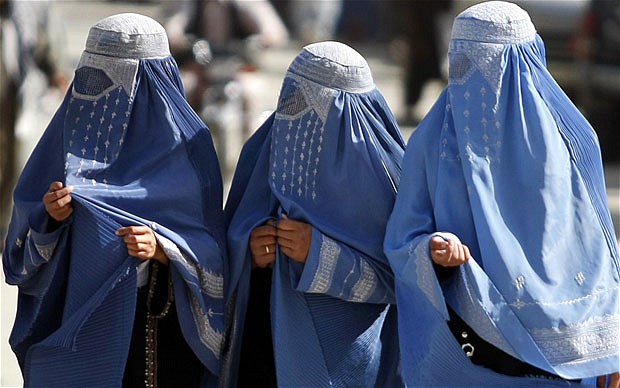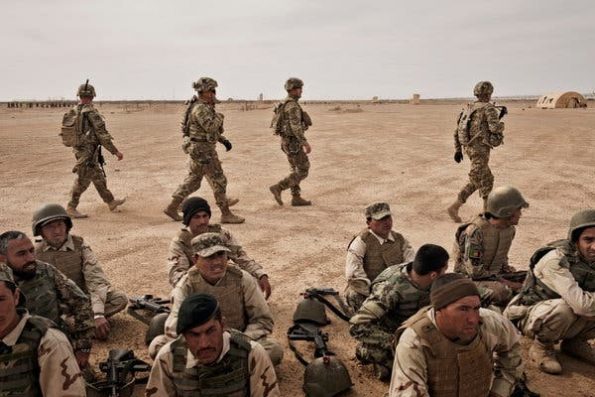
This article will critique the liberal peacebuilding agenda and argue for an alternative, post-liberal approach to peacebuilding and conflict research by drawing upon James Scott’s theory of everyday resistance in conjunction with my own recent research with rural women in the Hirat and Balkh provinces of Afghanistan. The objective of this article is to amplify the narratives and experiences of rural Afghan women in order to acknowledge their agency and ability, and in recognition of the potential they possess in terms of contribution to effective, sustainable peacebuilding processes. The potential of rural communities is largely neglected by liberal peacebuilding processes in Afghanistan, reflecting the problematic nature of the liberal peacebuilding agenda in general; namely that it is uniformly applied in a top-down approach.
|
By Sarah Edgcumbe |
The central aspect of liberal peacebuilding this article will focus upon is the problematic and tension-laden relationship between grassroots knowledge and agency on the one hand, and liberal institutions on the other. David Lewis, in his 2017 article on discourse, knowledge and authoritarian peace (Lewis, 2017: 21) elaborates upon how denial of local agency is an expression of power within the liberal peacebuilding paradigm, by pointing to his observation that ‘local conditions and local social fields are clearly subordinate to the dominant discourse of the liberal peace’ (Lewis, 2017: 41). Local knowledge which conforms to the liberal peacebuilding paradigm is incorporated, whereas knowledge that contradicts this paradigm is either reinterpreted and manipulated or discarded as invalid. According to Lewis, it is this neglect of local knowledge combined with the reification of expressions of agency which fail to conform to liberal norms as backwards, which results in alternative peace-building paradigms remaining under-researched and lacking in recognition as viable alternatives to liberal peace. Rather than adopting a case-by-case contextualised approach to peacebuilding based upon comprehensive research and inclusive, community-based consultations, the liberal peace agenda revolves around core pillars which are applied in a formulaic manner regardless of socio-political context and diversity on the ground. These core pillars are: state-building characterized by the establishment of liberal institutions and centralized governance, the implementation of neoliberal policies which seek to establish the free market economy through privatization of services and resources, the prioritization of security over development, an emphasis on the importance of individualistic civil and political rights over socio-economic and community-based rights, and finally, a top-down approach to peacebuilding which is exclusionary in nature due to its exclusive incorporation of the nation’s elite. In short, liberal peacebuilding can be viewed as a project of cultural imperialism in which dominant states seek to mould non-liberal and fragile states in their own image. It is what Sophie Richter-Devroe calls, ‘the peace of the powerful’ (Richter-Devroe, 2018: 15).
Afghanistan provides a lucid demonstration of the failure of the liberal peacebuilding agenda, despite attempts by the international community to sensitise it by employing a “light footprint” through capacity building measures (Hirst, 2011: 12). The reason for this failure, is largely due to the imposition and implementation of policies and strategies, which marginalise local knowledge and priorities, and instead, reflect external rather than internal concerns. For example, not only did the international community spend approximately $100 million per day on security compared to just $7 million per day on development during the first seven years of American-led occupation (Hirst, 2011: 18), it has also sought to frame Afghan women solely as victims of Afghan men, incorrectly heralding the 2001 invasion as a project in women’s liberation (Abu-Lughod, 2002: 784). Since 2001, the liberal state-building enterprise has continuously been presented as the most effective means of protecting and empowering women. This political discourse and corresponding imposition of externally-influenced policies, privileges the voices of external actors and male elites over the perspectives of rural Afghan women (Bond, 2019). The effect of this elite-centric approach to peacebuilding, is a discourse which emphasizes civil and political rights as the most effective vehicle through which to deliver women’s liberation, by way of detracting attention from the structural violence inherent within neoliberalism and exclusionary, centralized state-building.
Two Afghan strategies often presented as evidence of the improved conditions for Afghan women are the 2007 National Action Plan for the Women of Afghanistan, and Afghanistan’s 2015 National Action Plan on United Nations Security Council Resolution 1325. These documents include measures for increased protection of women, as well as greater representation of women in politics, security and the peace process. However, neither of these instruments includes any mechanism or framework through which to ensure inclusion of, or consultation with, rural women. Rather, rural women are assumed to be represented by the institutionalized “femocrats” and “peacewomen” (Richter-Devroe, 2018: 9) so beloved of liberal peacebuilding policies. It is therefore problematic that these elite women do not represent rural women’s values and concerns: The life experiences of wealthy, educated, urban women do not reflect those of illiterate peasant women who are engaged in a daily battle with extreme poverty, and who, as my research indicates, are supportive of patriarchal structures of authority, and sometimes also supportive of the Taliban. These rural women are primary carers for entire families and are keenly aware of the immediate problems facing their families and communities at a localized level. Despite their valuable experiences and perspectives however, they are rarely, if ever, provided with the opportunity to voice their concerns or suggestions regarding peacebuilding.
My own research in Afghanistan sought, in a small way, to address the neglect of rural women’s voices, and was conducted in such a way as to gain an insight into their experiences, values, perspectives and objectives. Despite the apparent assumption within liberal peacebuilding mechanisms that rural women are devoid of knowledge and agency, my research, which incorporated stratified samples (age, ethnicity, marital status, female and non-female headed households, internally displaced women and non-displaced women) comprising 130 rural women through eleven focus groups across Balkh and Hirat provinces, found that in fact, rural women actively engage in everyday resistance on a daily basis. My research utilised the theoretical framework of James Scott, scholar of anarchism, resistance and peasant politics, who developed the theory of everyday resistance, which examines the interplay between the powerful and the subordinate. Scott defines everyday resistance as ‘the ordinary weapons of relatively powerless groups: [such as] foot dragging, dissimilation, [or] false compliance…They require little or no coordination or planning; they often represent an individual form of self-help; and they typically avoid any direct symbolic confrontation with authority or with elite norms’ (Scott, 1985: 29). Importantly in the case of Afghan women, Scott later built upon this initial understanding of everyday resistance by developing his concept of ‘hidden transcripts’; a ‘risk-averse use of language by the powerless’ (Scott, 1990: 30), most notably taking the form of gossip, song, grumbling, storytelling and what many Afghan women refer to as “backbiting.” The more threatening the dominant manifestation of power, the more hidden acts of everyday resistance will be.
All but one of the rural women who participated in my research acknowledged regularly employing acts of everyday resistance. The most common resistance practices employed by the women were backbiting to each other about their husbands, maintaining a veneer of false deference, and subversive childrearing. Domestic violence, oppression (such as rigid gender norms and restrictions on their freedom of movement) and unfair demands within the domestic sphere were the foremost targets of resistance. Overall, the rural women who participated in my research supported a patriarchal structure of governance, provided that it was organic, benevolent, and conformed to their interpretation of Islam.
All of the rural women who participated in this research were beneficiaries of women’s empowerment programmes implemented by a small, predominantly Pashtun-staffed NGO; most were participating in vocational skills-based training which would enable them to generate an income for their family. Interestingly, the family home was the women’s most volatile site of resistance. Once they had secured permission from their husbands, fathers or brothers to leave the home, they ceased to express an intention to resist, instead acting in such a way as to support and reproduce patriarchal authority on the basis that patriarchal governance best complies with their interpretation of Islam, with Islam being of utmost importance to them.
The research participants’ motivation for seeking employment or income-generation was not driven by defiance or a desire to confront patriarchal systems, but simply to provide for their families in a context of extreme poverty, in which husbands are often unemployed. The participants viewed women working as acceptable within Islam but did not wish to be the recipients of development opportunities at the expense of their men, whom they also wished to see generating an income. Significantly, they did not necessarily wish for equal political opportunities, viewing men as being biologically predisposed to make better decisions on behalf of the community. The women’s encroachment upon public space and the labour market has, however, resulted in unintentional consequences; namely the transformation of patriarchal authority in such a way as to accommodate for the expanded gender roles of women. This shift in norms has taken place so subtly, and so organically that these newly expanded gender roles align comfortably with males retaining ultimate authority within the community. Meanwhile, the lack of confrontation inherent within this transformation has resulted in the expansion of women’s presence being accommodated by, and often supported by men.
Just as rural women are gradually and discreetly affecting social change within their communities in a way which complies with religious and cultural norms, so too are they working to reduce conflict within their communities, through everyday resistance practices which target both conflict and extreme manifestations of patriarchy. Focus group participants from Injil and Balkh districts both described their childrearing practices in such a way as to demonstrate that they are weaponising existing rigid gender roles, which position the mother as sole carer for children, utilising them in order to deploy their sons as agents for positive change. Saba Mahmood makes an observation which is poignant here, in explaining that ‘what may appear to be a case of deplorable passivity and docility from a progressivist point of view, may actually be a form of agency – but one that can be understood only from within the discourses and structures of subordination that create the conditions of this enactment. In this sense, the capacity for agency is entailed not only in acts that resist norms but also in the multiple ways in which one inhabits norms’ (Mahmood, 2006: 42). This recognition of the inherent transformative potential located within the interaction between cultural and social norms, local knowledge and agency are completely overlooked by top-down liberal peacebuilding processes, often resulting in policies being experienced as destructive or irrelevant at the local level.
In this case, the women deploy childrearing practices against conflict and extreme patriarchy by placing two distinct demands upon their younger sons. The first is that boys must be kind and respectful to girls and treat them as their equals. The second is an attempt to counteract the normalisation of violence and forbids their sons from hitting girls, but also from hitting their brothers, friends, or other boys within the community. This form of subversive childrearing has the potential to be the catalyst for gradual, but effective change in social norms among communities, as when general violence is dramatically reduced, a man hitting a woman will be amplified. Teaching their sons not to hit or argue with other children in the community is a proactive attempt by these women to ensure continued unity within the community, in turn contributing to increased conflict resilience. Moreover, the women also justify this approach to childrearing in terms of ensuring that their sons grow up to be good Muslims, contrary to many men in their community, whom the women view as exercising violence and coercion which is incompatible with Islam.
Despite the women intentionally employing childrearing practices which subvert existing social norms, many of the research participants were ambivalent towards the possibility of women obtaining positions of political authority within the community, while others were opposed to the idea, viewing politics as the domain of men. Rather, the women advocated for and raised their children in preparation for, a more benign system of patriarchal governance more sympathetic towards women. A research group in a particularly embattled village in Balkh district largely justified their support for patriarchal governance by pointing to the fact that despite violent conflict surrounding their community, and despite the presence of career criminals, their village had remained united and strong, through familial and communal bonds. This resilience persevered under patriarchal community rule, and so the women viewed this power dynamic as successful, regardless of the domestic violence they faced within the private sphere.
As has been illustrated throughout this paper, rural women are very much aware of the priorities they and their communities face. Importantly, they are keenly aware of those values and norms which the community views as non-negotiable and those which can be quietly, and subtly transformed, provided this action takes place in a non-confrontational manner. Thus, these women are extremely valuable bodies of knowledge and agency in terms of peacebuilding. To ignore them because their knowledge and perspectives do not always conform to liberal norms is to condemn rural Afghan communities to continued marginalisation, poverty and conflict. To unconditionally favour liberal peacebuilding, is also to neglect the potential applicability of other forms of peacebuilding.
Time and effort are required to adequately research the experiences, perspectives, values, and priorities of rural communities, but these insights are crucial for building a contextually specific framework which will result in sustainable peace. The Everyday Peace Indicators[1] framework developed by Pamina Firchow and Roger Mac Ginty is an inclusive, bottom-up approach to conflict and peace research which could be utilised in order to inform the creation of truly effective peacebuilding policies. This framework has already been applied to research in rural communities across two provinces of Afghanistan with significant success by the United States Institute for Peace.[2] Such a framework could underpin what David Roberts calls “popular peace”,[3] which ‘derives from local priorities serviced through able institutions, sustained, where they are lacking, through external cooperation.’[4] Indeed, popular peacebuilding measures would necessarily employ a bottom-up approach which would incorporate the currently marginalised voices of rural women and challenge the prevailing structural violence inherent within liberal peacebuilding mechanisms, which at worst achieve only a short-term cessation of conflict, and at best, result in long-term negative peace.
The overriding aspect of peacebuilding, which should be the foremost concern in conflict-based research and policy development is the fact that peace is not uniformly understood or homogenously experienced. For this reason, a consultative, participatory approach to understanding local conceptions of peace is crucial for formulating comprehensive policies to achieve sustainable peace in such a way that enables local communities to take ownership of, and responsibility for, their success. The current liberal peacebuilding paradigm is irrelevant and abstract to many people living in rural communities, who often feel disenfranchised by processes which exclusively incorporate and benefit the urban elite.
References
Abu-Lughod L, (2002), ‘Do Muslim Women Really Need Saving? Anthropological Reflections on Cultural Relativism and it’s Others’, American Anthropologist, 104 (3), pp783-790.
Bargues-Pedreny P, From the Liberal Peace to Pragmatic Peacebuilding to Reality of Post Conflict Zones, online. https://ecpr.eu/Filestore/PaperProposal/7af8b485-6d09-4db8-8c42-8fa681439109.pdf
Bond K.D et al, (March 4th 2019), ‘The West Needs to Take the Politics of ISIS Women Seriously’, Foreign Policy online.
Cavalcante F translated by Caldwell S, (2014), The Influence of the Liberal Peace Framework on the United Nations Approach to Peacebuilding in Guinea-Bissau, RCCS Annual Review: A Selection from the Portuguese Journal Revista Critica de Ciencias Sociais, 6 (6), pp141-161.
Everyday Peace Indicators website: https://everydaypeaceindicators.org/
Grau B, (2016), Supporting Women’s Movements in Afghanistan: Challenges of Activism in a Fragile Context, Gender and Development, 24 (3), pp409-426.
Hirst C, (2011), How Has the ‘Liberal Peace’ Served Afghanistan?, Journal of Conflict Transformation and Security, 1 (2), pp11-24.
Lewis D, (2017), The Myopic Foucauldian Gaze: Discourse, Knowledge and the Authoritarian Peace, Journal of Intervention and State-building, 11 (1), pp21-41
Mac Ginty R, (2010), Warlords and the Liberal Peace: Statebuilding in Afghanistan, Conflict, Security and Development, 10 (4), pp577-598.
Mahmood S, (2006), Feminist Theory, Agency and the Liberatory Subject: Some Reflections on the Islamic Revival in Egypt, The Finnish Society for the Study of Religion: Temenos, 42 (1), pp31-71.
Richmond O, (2011), A Post-Liberal Peace, Routledge.
Roberts D, (2010), From Liberal to Popular Peace?, Open Democracy, https://www.opendemocracy.net/en/from-liberal-to-popular-peace/
Richter-Devroe S, (2018), Women’s Political Activism in Palestine: Peacebuilding, Resistance and Survival, University of Illinois Press.
Scott J, (1985), Weapons of the Weak: Everyday Forms of Peasant Resistance, Yale University Press.
Scott J, (1990), Domination and the Arts of Resistance: Hidden Transcripts, Yale University Press.
Urwin E and Belquis A, (2018), Measuring Peace and Violent Extremism: Voices from the Afghan Village, United States Institute for Peace, https://www.usip.org/index.php/publications/2018/03/measuring-peace-and-violent-extremism
[1] https://everydaypeaceindicators.org/
[2] https://www.usip.org/index.php/publications/2018/03/measuring-peace-and-violent-extremism
[3] https://www.opendemocracy.net/en/from-liberal-to-popular-peace/
[4] https://www.opendemocracy.net/en/from-liberal-to-popular-peace/
To Download the PDF, click here…



